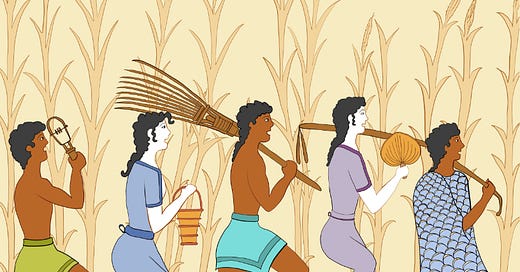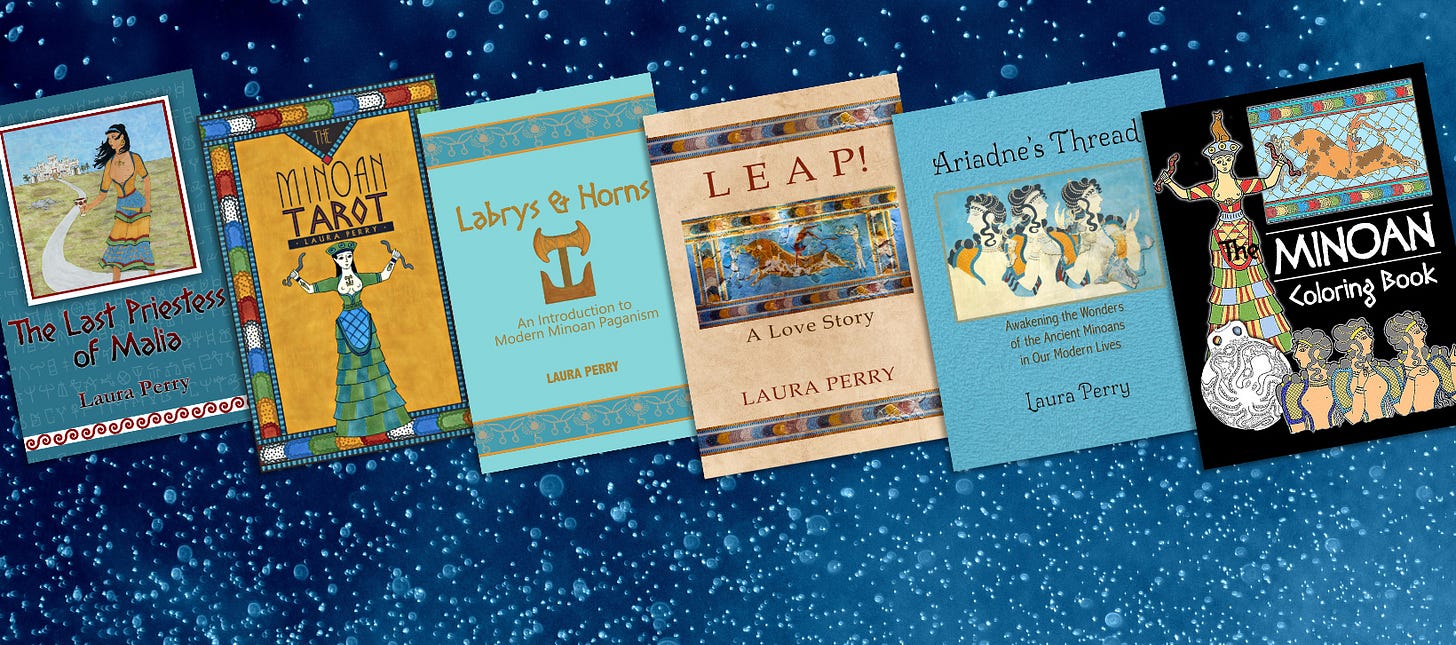I’m sharing some of the stories from my upcoming book of modern Minoan myths, Tales from the Labyrinth, in the runup to the book’s release at Summer Solstice, 21 June 2025. These are retellings of the tales of the Minoan people and their deities, from the perspective of modern inclusive Minoan spirituality as we experience it in Ariadne’s Tribe. You can find all the preview chapters here.
Today’s story is about the grain harvest, which takes place in the spring in the Mediterranean, after the mild winter rainy season which is also the growing season.
We’re coming up on harvest time right now, so I felt this was a good time to share this one. The mythos is inextricably intertwined with the sacred calendar, and the time of year tells us which tale is “alive” at any given moment.
The illustration above is the one that goes with this story. For those who are familiar with Minoan art, this one was inspired by the Harvester vase from Hagia Triada. I’ve created a full-page color illustration to go with each story, all in the style of ancient Minoan art but with a gently modern vibe. After all, as Alice said, what good is a book without pictures?
Here, then, is the tale of the harvest:
The rains had been plentiful, steady and gentle, generous enough for strong growth in the fields but not so overwhelming as to cause flooding in the farms or towns. The wheat and barley, sown last autumn just as the first rains softened the soil, had grown steadily through the winter. Now that Spring Equinox approached, the heads of grain were ripening, turning the gentle golden color of honey under the warm springtime Sun. The time had come to harvest the grain and give thanks to the ancestors and the Grain-Mother, the goddess Rhea, for another good year of plenty. The people rejoiced that they would have enough and some to share.
The people of Crete knew that the ancestors provided for them; after all, the bodies of their beloved dead were a part of the Earth from which the crops grew. But the people also saw a special sign that told them the ancestors were watching over them and blessing their crops. You see, every year without fail, poppies grew in the fields of wheat and barley. The people were well-versed in the medicinal properties of this flower, its seeds, and its sap. They knew the Poppy Goddess—one of the goddess Eileithyia’s faces—offered them relief from pain and brought blissful sleep. The bees buzzing around the poppy blossoms in the grain fields reminded them that this plant was a gift from the Melissae, the ancestral bee-goddesses who looked after the Blessed Dead. And just as the poppy offered sleep, so the Poppy Goddess offered a peaceful transition into the land of the ancestors, beyond the world of the living.
As they reaped their fields of grain, the people were careful to leave the poppies unharmed so these special flowers could bless the fields again the following year. So they swung their scythes with skill and cut down just the golden heads of wheat and barley, sparing the poppies. When the people had gathered all the grain, they sang and danced in celebration, shaking sistrums and calling out their gratitude to the ancestors and the Grain-Mother as they carried their harvest in from the fields. But their labor was not finished yet.
Many hands make light work, so the people gathered together on the circular threshing floors to separate the grains from the stalks. But the grains were still covered in dry hulls that had to be removed before the grain could be used for food. So the people worked together with baskets and hand fans to winnow away the chaff, which is another name for the hulls and other bits of the dry plants that were still attached to the grain. They did this in pairs: One person would pour the grain back and forth from one basket to another. As they poured the grain, the other person would wave their fan vigorously, creating a breeze that blew away the lightweight hulls while the heavier grain dropped into the basket.
Once again the people chanted and sang as they walked in rhythm around the circle and as they poured the grain between the baskets and fanned the chaff away. When the grain was finally cleaned, they poured it into the giant pots they used to store each year’s crop. These same pots—pithoi, they were called—were also the resting places of the ancestors’ bones in the great beehive-shaped tombs all over the island. The people knew, too, that it was a pithos like these from which all of Ida’s gifts came, the sacred womb-symbol of Rhea Pandora, the All-Giver.
With the grain safely harvested and stored, the people could finally relax and rejoice. With loving care they ground the grain into flour, baking it into the season’s first loaf of bread that would be given, as a gift of thanks, to the ancestors. And as the bread was baking, the people prepared a huge feast for everyone to enjoy. They set places for each other at the table, and they also set places for the ancestors, their honored guests, because they knew that to be remembered is to be loved.
My Substack is free, but I appreciate your support for my work by liking, commenting, and sharing these posts and by purchasing my creations. You can find my books here and my art here and here.
About Laura Perry
I'm the founder and Temple Mom of Ariadne's Tribe, a worldwide inclusive Minoan spiritual tradition. I'm also an author, artist, and creator who works magic with words, paint, ink, music, textiles, and herbs. My spiritual practice includes spirit work and herbalism through the lens of lifelong animism. I write Pagan / polytheist / magical non-fiction and fiction across several different subjects and genres. My Minoan entry in the Moon Books Pantheons series is now available for pre-order and will be released on 26 August 2025. While that process percolates along, I’m working on an illustrated book of modern Minoan myths. I’m also an avid herb and vegetable gardener and living history demonstrator.







A lovely story of harvest.
I am interested in your thoughts on seasons, myths, and honoring the God and ancestors. Harvest, for me, is autumn. How might this, or should this, play into honoring the Gods from different part of the world?
I look forward to reading it